
Developers Manual 1.20


|
 |
2. Persistency
You have successfully completed your class specifications, connected ReStore, and constructed your tables.
You are now ready to begin using ReStore for real - creating and working with persistent objects.
Tracing
![]()
When developing with ReStore, it can sometimes be useful (or just plain
interesting!) to find out what is going on 'behind the scenes'. If you have a
basic familiarity with SQL (the language in which ReStore talks to your
database) then you can elect to have all SQL issued by ReStore sent to the
Transcript or a FileStream (or any object that responds to a Stream protocol).
Examples:
"Log all SQL to the Transcript"
aReStore debugTo: Transcript"Log all SQL to a File"
file := FileStream write: 'c:\temp\sql.txt'.
aReStore debugTo: file."Turn off SQL logging"
aReStore debugTo: nil
2. Persistency